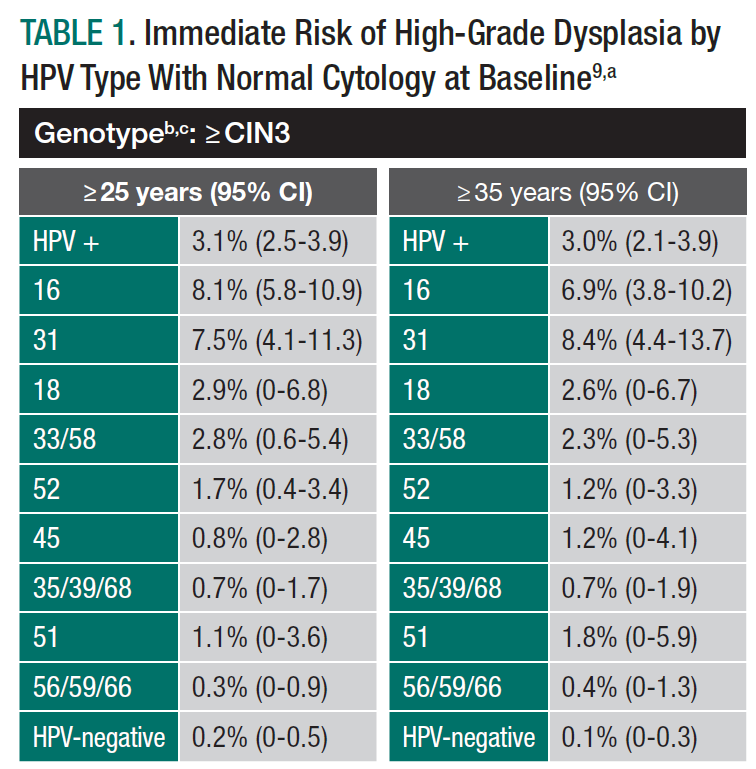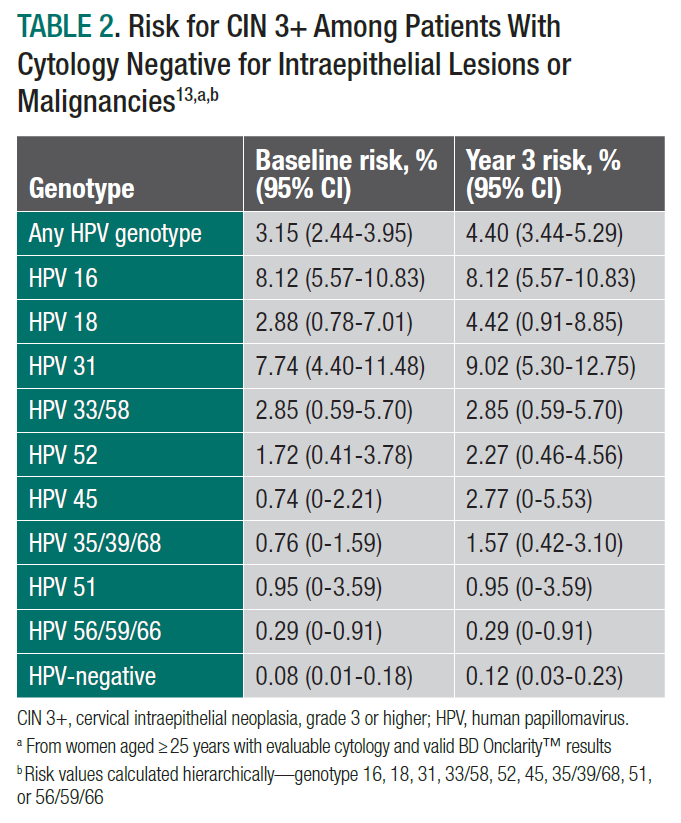An HPV Test With Extended Genotyping to Individualize Cervical Cancer Screening
This article was sponsored by Becton, Dickinson and Company.

Introduction
Rates of cervical cancer have decreased markedly in the United States with the implementation of screening and vaccination programs for human papillomavirus (HPV), which causes more than 9 out of 10 cases of cervical cancer.1,2 However, each year, approximately 200,000 women are diagnosed with a cervical precancer, 11,000 women receive a diagnosis of cervical cancer caused by HPV infection, and 4000 women die from the disease.1,2
HPV Vaccine Impact
Nearly all cervical cancers could be prevented with HPV vaccination and routine cervical cancer screening. HPV vaccination is recommended between the ages of 11 and 12 years, or as early as age 9.2,3 HPV types 16 and 18 have been most commonly implicated in the development of high-risk infections; quadrivalent vaccines (covering types 6, 11, 16, and 18) that were licensed for use in the United States in 2006 have substantially decreased the prevalence of these types.1,4 The nonavalent HPV vaccine, licensed for use in the United States in 2014, covers types 31, 33, 45, 52, and 58 in addition to those covered by the quadrivalent vaccine; however, approximately 15% of cervical cancers are caused by HPV types not covered by the 9-valent vaccine, further emphasizing the continued need for regular cervical cancer screening, even among those who are vaccinated.1
As the vaccinated population increases, the relative prevalence of HPV types 16 and 18 have decreased, and HPV types that are not covered by the vaccine are rising in prevalence. Women who receive the quadrivalent vaccine are within the screening population and are only protected against HPV 16 and 18, not all high-risk types. The same will be true for those who received the nonavalent vaccine; patients will only be protected against the 9 HPV types covered by the vaccine. These combined factors further emphasize the need for better ways to screen for cervical cancer beyond just individually identifying HPV 16 and 18.1,4-6
Cervical Cancer Screening Methods
As of 2018, the US Preventive Services Task Force (USPSTF) recommends cervical cancer screenings for women aged 30 to 65 years every 5 years with only high-risk HPV testing or co-testing and every 3 years with only cytology for women aged 21 to 65 years.7 Similarly, the American Cancer Society 2020 guidelines on cervical cancer screening support cervical screening every 5 years via primary HPV testing alone or via co-testing, or every 3 years with cytology alone, for women aged 25 to 65 years who have a cervix. However, the guidelines state that primary HPV testing every 5 years is the preferred screening method and the other methods are considered acceptable if primary HPV testing is not available.6 Screening with cytology alone every 3 to 5 years increases the identification and management of precancerous cervical intraepithelial neoplasia (CIN) and reduces the risk of cervical cancer development by 80%; however, HPV screening has greater sensitivity for detection of CIN that is grade 2 (ie, abnormal cells found in one-third to two-thirds of the cervical epithelium) or higher (CIN2+), which may enable earlier intervention at a more treatable stage of disease.3 Additionally, cervical cytology offers decreased sensitivity for CIN2+ among individuals fully vaccinated for HPV (considered ‘fully vaccinated’ if initiated at age 14 or younger and at least 2 doses administered); it is expected that the overall performance of cytology at the population level will continue to worsen as more fully vaccinated individuals become old enough for screening.8 Primary HPV testing is preferred over co-testing, because the latter involves more frequent testing and may increase the incidence of screening-related adverse outcomes in individuals aged 25 to 29 years, including a higher number of colposcopies due to transient infections, associated stress, and increased risk of adverse obstetrical outcomes in those who undergo cervical excisional procedures.6
Importance of High-Risk HPV Genotype Identification and Tracking
Most individuals who test positive for HPV do not go on to develop high-grade dysplasia or cervical cancer. Therefore, identifying factors that are associated with high-grade cervical disease is important to predict the risk of developing high-grade CIN.9 The American Society for Colposcopy and Cervical Pathology (ASCCP) 2019 Management Guidelines use current and past results and other factors to assess an individual patient’s immediate risk of developing or having CIN that is grade 3 (ie, CIN3, abnormal cells affecting the entire thickness of the cervical surface layer) or greater (CIN3+). This framework was designed to adjust to the rapidly emerging science and new technologies as they become available.10 The ASCCP recognizes 2 key factors that contribute to the development of high-grade cervical disease: 1) high-risk HPV genotype and 2) persistent infection with the same HPV type.3,10,11 The most common high-risk types linked to CIN3+ in the United States, from more to less prevalent, HPV 16 > 31 > 52 > 18.9,11
Persistent HPV infections with the same type are associated with a high risk for CIN3+, even if negative results are found with initial cytology and colposcopy.3 By contrast, high-grade CIN is uncommon among patients who have clearance followed by positivity with a different HPV type.3 Taken together, these factors associated with development of CIN3+ highlight the need for HPV tests that can individually identify multiple high-risk HPV types and track persistent infections.9 For patients at higher risk, the ASCCP recommends more frequent surveillance, colposcopy, or treatment; by contrast, those at lower risk can receive follow-ups less frequently and do not require further diagnostic evaluation with colposcopy.10


HPV Testing With Partial Genotyping
HPV testing with partial genotyping is the most commonly used type of HPV test in the United States. It provides results for HPV types 16 and 18 or 18/45 along with a single pooled result that can identify, without specifying the genotype, the presence of 1 of 12 other high-risk HPV genotypes. As mentioned previously, most individuals who test positive for HPV do not go on to develop high-grade CIN; thus, primary HPV screening with partial genotyping is followed by reflex to cytology for any positive HPV results. In the case of HPV 16 and 18, patients are referred immediately to colposcopy. Those positive for the 12 pooled types will need cytology to determine the appropriate management. HPV 31 confers a greater risk for high-grade CIN than does HPV 18. Use of an HPV test that does not specifically identify HPV 31 or other high-risk types (partial HPV genotyping) may mask the true risk of high-grade disease, provide limited ability to monitor genotype specific persistence, and lead to less precise management and surveillance strategies. Therefore, more expansive testing that identifies other high-risk HPV types individually is clinically relevant.9
HPV Testing With Extended Genotyping
The BD Onclarity™ HPV Assay (Becton, Dickinson and Company)—currently the only HPV test with extended genotyping (xGT) approved by the FDA—individually identifies HPV types 16, 18, 31, 45, 51, and 52 along with types 33/58, 35/39/68, and 56/59/66 in smaller pooled combinations based on similar risk profile.12 The BD Onclarity™ clinical trial, which involved a baseline phase and a 3-year longitudinal phase, was conducted to assess the performance of the test.13 Participants at baseline were 29,883 women 25 years or older who underwent routine cervical cancer screening (via co-testing) across 31 sites in the United States between August 26, 2013, and June 12, 2015. Colposcopy referrals were made for all women with ≥ atypical squamous cells-undetermined significance (ASC-US) cytology or those who were HPV+ regardless of cytology. Approximately 5% of co-test negative women were referred, at random, to colposcopy/biopsy.13 In the baseline phase of the BD Onclarity™ trial, findings of CIN3+ were most frequently associated with the presence of HPV types 16 (11.2%), 31 (7.5%), 18 (2.9%), and 33/58 (2.8%). HPV genotypes 16 and 31 had the highest risk values for the ≥ 25 year (8.1% and 7.5%, respectively) and ≥ 30 year (6.9% and 8.4%, respectively) age groups with normal cytology at baseline, exceeding the 4% risk threshold for colposcopy that is recommended by the ASCCP (Table 1).9 Based on these data, HPV 31 poses a similar risk to HPV 16 for high-grade disease, and patients positive for HPV 31 may benefit from similar management under the ASCCP guiding principle “equal management for equal risk.”9
The 8427 patients who underwent colposcopy at baseline were evaluated annually with routine clinical testing and follow-ups as appropriate in the 3-year longitudinal phase; they were not excluded in the baseline phase, had valid histology results, and had not received treatment for high-grade CIN. Among patients with normal cytology at baseline, those infected with HPV 31 had the highest 3-year cumulative risk for CIN3+ (9.02%; 95% CI, 5.30%-12.75%), followed by type 16 (8.12%; 95% CI, 5.57%-10.83%) and type 18 (4.42%; 95% CI, 0.91%-8.85%) (Table 2).13 The risks for CIN3+ with negative findings for intraepithelial malignancies (NILM) cytology at baseline and within 3 years with types 31 and 16 were high enough to warrant immediate colposcopic referral.13

Data were used to analyze 5 different screening approaches. The primary HPV 16/18/31 strategy (xGT31) outlined that women with an HPV-negative result would return to routine screening; women with an HPV 16, 18, or 31 result would receive an immediate colposcopy regardless of cytology; and women with a positive HPV result for any of the other 11 genotypes would receive a colposcopy if they had a cytology result of ≥ ASC-US but a 1-year follow up if they had negative cytology. The primary HPV 16/18/31 xGT strategy (xGT31+) was similar. This risk-based strategy refers women who are positive for HPV 16, 18, or 31 to immediate colposcopy. The remaining “other 11” genotypes were triaged with cytology and from that pool, all women with more than a low-grade squamous intraepithelial lesion (LSIL) would receive an immediate colposcopy. Those with NILM cytology would return for testing at follow-up. The remainder of the women (those with ASC-US or LSIL cytology) were managed based on the corresponding Onclarity assay results: those who were positive for HPV 33/58, 45, or 52 would be referred to immediate colposcopy and those who were HPV 35/39/68, 51, or 56/59/66 would return for testing at follow-up.
Researchers also found that cumulative risk for CIN3+ was nearly 3 times higher at 3 years in individuals who had a persistent infection with the same HPV type (4.2%; 95% CI, 2.7%-6.0%) compared with those who had a type clearance followed by new positivity (1.5%; 95% CI, 0.0%-4.1%) over the time period.13
Conclusions
On the basis of the findings from the BD Onclarity™ clinical trials, the authors concluded that individually identifying additional HPV types in screening, particularly HPV 31, improves risk stratification for CIN3+ compared with partial genotyping limited to types 16 and 18.13 These findings also support consideration of early diagnostic testing via colposcopy (and potential treatment) for patients who test positive for HPV 31, similar to the current management of HPV 16 and 18. Identification of HPV 31 also supports early diagnostic testing (with colposcopy) and potential treatment of high-grade CIN to a greater number of patients who could benefit.9
Use of xGT to identify HPV types associated with intermediate risk (eg, types 33/58, 52, and 45) and lower risk (eg, types 35/39/68, 51, and 56/59/66) for CIN3+ may also help to reduce the number of unnecessary colposcopies by supporting a more conservative approach. Because same-type persistence for 1 to 3 years was associated with a substantially greater risk for CIN3+, xGT that identifies a greater number of high-risk HPV types can also aid with tracking the presence of a specific HPV type for those individually reported.13 Under the current basis for triage in screening, “equal management for equal risk,” the ASCCP management guidelines may be further refined by incorporating xGT results.9,10
1. Meites E, Gee J, Unger E, Markowitz L. Epidemiology and prevention of vaccine-preventable diseases. Human papillomavirus. CDC. Reviewed August 18, 2021. Accessed August 1, 2023. https://www.cdc.gov/vaccines/pubs/pinkbook/ hpv.html#vaccines. 2. Human papillomavirus (HPV). Cancers caused by HPV. CDC. Reviewed February 28, 2022. Accessed August 1, 2023. https://www.cdc.gov/ hpv/parents/cancer.html. 3. Elfgren K, Elfström KM, Naucler P, Arnheim- Dahlström L, Dillner J. Management of women with human papillomavirus persistence: long-term follow-up of a randomized clinical trial. Am J Obstet Gynecol. 2017;216(3):264.e1-264.e7. doi:10.1016/j.ajog.2016.10.042. 4. Wright TC Jr, Parvu V, Stoler MH, et al. HPV infections and cytologic abnormalities in vaccinated women 21-34 years of age: results from the baseline phase of the Onclarity trial. Gynecol Oncol. 2019;153(2):259-265. doi:10.1016/j. ygyno.2019.02.016. 5. Trama JP, Trikannad C, Yang JJ, Adelson ME, Mordechai E. High-risk HPV genotype distribution according to cervical cytology and age. Open Forum Infect Dis. 2022;9(11):ofac595. doi:10.1093/ofid/ofac595. 6. Fontham ETH, Wolf AMD, Church TR, et al. Cervical cancer screening for individuals at average risk: 2020 guideline update from the American Cancer Society. CA Cancer J Clin. 2020;70(5):321-346. doi:10.3322/caac.21628. 7. US Preventive Services Task Force. Screening for cervical cancer: US preventive services task force recommendation statement. JAMA. 2018;320(7):674–686. doi:10.1001/ jama.2018.10897. 8. Teoh D, Nam G, Aase DA, et al. Test performance of cervical cytology among adults with vs without human papillomavirus vaccination. JAMA Netw Open. 2022;5(5):e2214020. doi:10.1001/ jamanetworkopen.2022.14020. 9. Stoler MH, Wright TC Jr, Parvu V, Yanson K, Cooper CK, Andrews JA. Stratified risk of high-grade cervical disease using onclarity HPV extended genotyping in women, ≥25 years of age, with NILM cytology. Gynecol Oncol. 2019;153(1):26-33. doi:10.1016/j.ygyno.2018.12.024. 10. Perkins RB, Guido RS, Castle PE, et al; 2019 ASCCP Risk-Based Management Consensus Guidelines Committee. 2019 ASCCP risk-based management consensus guidelines for abnormal cervical cancer screening tests and cancer precursors. J Low Genit Tract Dis. 2020;24(2):102- 131. doi:10.1097/LGT.0000000000000525. 11. Monsonego J, Cox JT, Behrens C, et al. Prevalence of high-risk human papilloma virus genotypes and associated risk of cervical precancerous lesions in a large U.S. screening population: data from the ATHENA trial. Gynecol Oncol. 2015;137(1):47-54. doi:10.1016/j. ygyno.2015.01.551. 12. BD receives FDA approval for HPV test with extended genotyping capabilities. News release. Becton Dickinson. July 22, 2020. Accessed August 2, 2023. https://news.bd.com/2020- 07-22-BD-receives-FDA-Approval-for-HPV-Test-with-Extended- Genotyping-Capabilities. 13. Stoler MH, Wright TC Jr, Parvu V, Yanson K, Cooper CK, Andrews JA. Detection of high-grade cervical neoplasia using extended genotyping: performance data from the longitudinal phase of the Onclarity trial. Gynecol Oncol. 2023;170:143- 152. doi:10.1016/j.ygyno.2023.01.004
Download this PDF here.